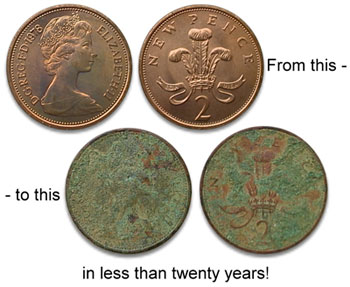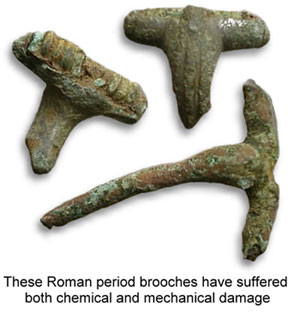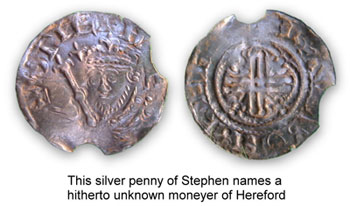Metal detecting is a truly fascinating hobby, which is enjoyed by people of all ages and from many different backgrounds. It is not only a stimulating recreational pursuit, however, it is also a source of valuable information, which is adding very considerably to our knowledge of the past. In fact, the hobby’s contribution has a particular significance. It provides information about lost and discarded items, which otherwise would never be known. Importantly, it rescues these items from hostile environments that threaten their rapid destruction.
Not so, argue the hobby’s detractors. Metal detecting is depleting the archaeological pool and resulting in the loss of contextual information. Detectorists are reluctant to record their finds, and the hobby’s contribution to knowledge is minimal. Interest in the hobby is driven primarily by financial gain.
So, what is the reality of the situation? Let us consider the issues raised, starting with the ‘archaeological pool’ and its ‘depletion’.
In the context of metal detecting, the ‘archaeological pool’ is the body of small man-made items in the ground, which have been lost, discarded or buried. Some of them have the potential to add to our knowledge of the past, but while they remain undiscovered they contribute nothing. It is only when they are recovered, whether by metal detectorists, archaeologists or members of the general public, that they provide any information at all. However, the great majority of items in this pool will only ever be discovered as a result of metal detectorists pursuing their hobby. Furthermore, while they remain in the ground they are exposed to a very severe risk of destruction. The emotive phrase, ‘depleting the archaeological pool’, is therefore entirely misleading, because it implies a net loss to our knowledge, as opposed to a net gain. Far from taking anything away, detectorists are adding to our knowledge by discovering and recording material that otherwise would have been lost forever. In fact, the reality of the situation is far better expressed, if the negative and propagandist, ‘depleting the archaeological pool’, is replaced with the more meaningful, ‘rescuing our material heritage’.
And ‘rescuing’ is the operative word. Few people outside archaeology and the metal-detecting hobby have any appreciation of the rate at which our undiscovered material heritage is being destroyed.
The vast majority of metallic objects that remain in the ground are condemned to certain destruction as a result of the intensive agricultural practices and land development that are associated with modern living. Agrochemicals, for example, will completely destroy a base-metal object within a few years of being in the ground. Many ancient coins and artefacts will have survived in good condition in the soil for nearly two millennia, only to be completely destroyed in the last fifty years.
The two modern coins shown opposite are of bronze, and of a type that was struck between 1971 and 1981. The upper coin is in as-struck condition. The lower coin is a metal-detecting find made in the early 1990s. It was probably in the ground for less than twenty years, but is so severely damaged by chemical attack that it is not even possible to read the date.
Chemicals, however, are not the only threat faced by objects in the ground. The mechanisation of almost every aspect of agriculture makes long-term survival of any object within ploughsoil virtually impossible. Pre-historic stone implements and metallic objects are equally vulnerable. Even the smallest and lightest of items are cut to pieces, and any information they might have yielded is lost forever. The medieval silver coins shown below are all less than 20 mm diameter, but nothing escapes the high-speed blades of modern cultivators.
And it is not only in the fields that mechanisation is taking its toll. Rivers and other waterways are being dredged to increasingly greater depths in order to improve land drainage. The consequence of this is that many fords and archaeological structures are being destroyed because they present obstacles to flood water. Artefacts and coins are disturbed from these safe environments, and become damaged by gravels and rocks as they are carried downstream.
In the light of the conditions described above, it is instructive to consider a hypothetical situation. A member of the public is walking across a field and notices a Roman brooch protruding from the soil. Should he retrieve it or leave it in the ground? If he retrieves it, it can be photographed, measured, weighed, analysed, conserved and recorded.
If he leaves it in the ground, its identity and details will never be known, and it will probably be destroyed in a short space of time when the field is ploughed and sprayed. If you believe that the responsible course of action is to leave the brooch in the ground, join the hobby’s detractors, and you will find yourself amongst like-minded people. However, if you believe that it is better to retrieve the brooch, ask yourself this question. What makes this accidentally discovered brooch any different to all the other brooches, coins and artefacts that are discovered with the aid of a metal detector?
Before moving on to the next issue, ‘loss of contextual information’, it is appropriate to draw attention to an important point regarding the respective modi operandi of archaeology and metal detecting. Archaeologists usually focus their attention on sites of intensive past human activity, whereas hobbyists search vastly greater areas, the majority of which will have seen only limited activity. The contribution that each group makes to our knowledge of the past is consequently of a different, but complementary nature.
Context, from an archaeological perspective, relates to the depth and relative positions of buried objects in an undisturbed environment, and it provides valuable information about their age and use. The key phrase, however, is ‘in an undisturbed environment’. The vast majority of land searched by metal detectorists is cultivated agricultural land, and the objects recovered are from the ploughsoil. Their depth and precise position within the ground are very unlikely to have any significance, but nevertheless their general location plays an important part in contributing to our knowledge of the past. The distribution patterns of individually lost objects, for example, can shed light on aspects of our history that conventional archaeology is not able to illuminate. The ‘horizontal context’, as it has been described, can make a unique contribution.
So, on what basis do the detractors make their claim that metal detecting results in a ‘loss of contextual information’? As already indicated, the vast majority of land searched by detectorists either is, or has previously been, under cultivation. This can therefore be eliminated as a potential area of ‘risk’. Similarly, all archaeological sites that have ‘Scheduled Monument’ status, and those that are otherwise protected by legislation, are out-of-bounds to the hobby, so they, too, can be eliminated. And excavated spoil from land development projects can hardly justify their concern.
The land that remains (predominantly undisturbed pasture) is a very small proportion of the total that is detected, and any unknown archaeological sites that exist on it will, by statistical probability, represent only a small fraction of the area. The actual risk of unwittingly disturbing items in an archaeological context is therefore extremely low. Notwithstanding this minimal risk, all responsible hobbyists detect in accordance with codes of practice that address this situation to ensure that the maximum amount of information is preserved. The reality is that archaeological sites accidentally discovered as a result of metal detecting are sites that would probably never otherwise have been discovered.
To realise their potential in providing information about our past, it is, of course, not only important to rescue objects from their hostile environment, but also to ensure that they are recorded and published. By doing so, details of the object are available for study, both in their own right, and in the context of related items and locations.
A coin, for example, may provide evidence of a hitherto unknown moneyer, like the silver penny of Stephen illustrated here. The collective recording of many coins, which individually might be insignificant, can establish where and under whose authority they were struck, their area of circulation, and even tribal boundaries. Analysis of findspots of Celtic and early Anglo-Saxon coins in England, for example, has significantly increased our understanding of these periods of our history. The facilities available for recording finds made in the UK are probably the best in the world. The UK Detector Finds Database (UKDFD) offers detectorists a hobby-based self-recording scheme, and the government-sponsored Portable Antiquities Scheme (PAS) provides recording via a network of Finds Liaison Officers. In addition, the Celtic Coin Index (CCI) and the Early Medieval Corpus (EMC) provide facilities for the recording of coins from these two periods. All these databases are online and freely accessible to the public, and the content of all of them owes a great deal to the metal-detecting hobby.
The publication of detecting finds on the Internet, however, is only one aspect of the hobby’s contribution to knowledge. Long before the Internet became available, detecting finds were being recorded and published by more conventional means, and these continue to play an important role. Authors from within the hobby have played a significant part in this process, and many others have acknowledged the contribution that metal detecting has made.
So, with hundreds of thousands of individual detector-find records in the public domain, and every indication that the rate of recording is increasing, how do the hobby’s detractors come to the conclusion that ‘detectorists are reluctant to record their finds’? The answer is that they don’t!
A conclusion is, by definition, “an opinion formed after considering the relevant facts or evidence”. The hobby’s detractors are not concerned with considering relevant facts or evidence; they are concerned only with achieving their objective of seeing the introduction of legislation to restrict the hobby. Accordingly, they fabricate ludicrous statistics to support their aims and mislead those, particularly legislators, who are not conversant with the facts. Nowhere is this more apparent than in their claims regarding the numbers of ‘recordable finds’ made by detectorists.
Everything that is dug is, of course, recordable, including all the shotgun cartridges, drink-can pull-tabs and irregular, nondescript fragments of metal that form the vast majority of ‘finds’ made by the detectorist.
It is absurd to suggest that resources should be wasted recording material that will add nothing to our knowledge, and, as everyone involved with recording detectorists’ finds knows, there is a diverse range of material that falls into this category. The ratio of junk to worthwhile finds made by detectorists varies considerably depending on the site, but it is by no means unusual for it to be of the order of one hundred to one. And even when a worthwhile find is made, it is frequently the case that recording would serve no useful purpose. Modern coins, for example, may well be regarded as good finds, but their recording is extremely unlikely to add anything to our historical or numismatic knowledge. Collectively, detectorists do make large numbers of finds that are worth recording, and in a small number of cases, the finds are spectacular and valuable. The latter are often in the form of hoards, which by their very nature were hidden in remote uninhabited areas, and are unlikely to be discovered by traditional archaeological methods. Such valuable finds, however, are quite exceptional. Nothing highlights the ignorance of the hobby’s detractors more than their assertion that detectorists are motivated by financial gain. Experienced hobbyists treat such claims with the contempt that they deserve, and anyone entering the hobby with such an aim would very rapidly become disillusioned and leave.
In summary, the portrayal of metal detecting by its detractors is one that few informed people, inside or outside the hobby, would recognise. Their propaganda is characterised by distortions and misuse of statistics to portray the hobby in a negative light. They blur the distinction between hobbyists and criminals that use metal detectors, just as they blur the distinction between archaeological sites and land that has no known archaeological significance. They do likewise with spurious statistics regarding numbers of finds made and recorded, deliberately choosing to ignore the fact that the vast majority of items recovered are of no archaeological or historical significance. However, the reality of the hobby’s contribution to knowledge is plain for everyone to see. It is evident in the display cases of our museums, the records on our databases, and the publications on our bookshelves.
User Tag List
Results 1 to 1 of 1
Threaded View
-
30-03-2014, 01:52 PM #1Administrator


- Join Date
- Aug 2005
- Posts
- 2,109
- Total Downloaded
- 0
- Points
- 0
- Mentioned
- 0 Post(s)
- Tagged
- 0 Thread(s)
Metal Detecting - The Hobby and its Detractors
Last edited by Rod; 30-03-2014 at 04:44 PM.
Thread Information
Users Browsing this Thread
There are currently 10 users browsing this thread. (0 members and 10 guests)









 Reply With Quote
Reply With Quote